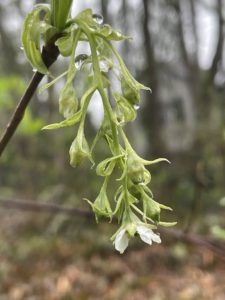
Frequently Observed Native Plant Species at Westlake
Westlake Oak Woodland gets its name from its majestic canopy of Oregon white oaks.
Oregon white oak is an important keystone species and oak habitats are complex. One of the many gifts Oregon white oaks offer is their ability to regulate ecosystem processes like nutrient cycling and energy flow, and provide shade for a vibrant diversity of wildlife.
You can view the entire list of commonly identified native species in Westlake Oak Woodland here.
Check out below for some of our spring plant highlights!
Camas (Camus leichtlinii)
Patches of violet-blue Camas are an iconic pop of color seen in moist meadows across Oregon in late spring. We are very lucky to have the C. leichtlinii, or Great Camas, a larger but less abundant variety scattered amongst the oaks at Westlake. The six-petaled flowers vary in color from pale lilac or white to deep purple or blue-violet. Camas are not only beautiful but are also a first food for many Indigenous people throughout the Northwest. The bulbs are rich with complex carbohydrates and sugars, and can be dried, roasted, boiled, or eaten raw.
Learn more about the local impact of protecting and growing Camas as a first food here.

“At a short distance, the colour resembles lakes of bright clear water.”
–Meriwether Lewis, 1806.
Osoberry (Oemleria cerasiformis)
In the Pacific Northwest, Osoberry is one of the earliest bloomers. Its white flowers appear in the early spring, providing a nectar source to hummingbirds, butterflies, bees, and other pollinators. Mammals such as coyotes and bear eat the berries, which resemble small plums. Indigenous peoples also include the berries in their diet, make tea of the bark and use the twigs as a mild anesthetic.
Licorice Fern (Polypodium glycyrrhiza)

This fern’s botanical name means “many footed” and “sweet root,” and refers to the — you guessed it — sweet licorice flavor of its roots, and is known to be an important medicinal to Indigenous herbalists. You can find licorice
ferns hiding in the moss high up on the trunks of oaks. They have zigzag-y leaves and large spore packets on the underside of each frond called sori.

Oak Mazegill (Daedalea quercina)
These mushrooms with distinct mazelike surfaces are commonly found on rotting Oregon white oak stumps and logs. D. quercina are found all over the world following the pattern of oak distribution, their preferred meal. Though they are inedible, fruit bodies of D. quercina have been used as a natural comb for horses and also for anesthetizing bees in England. This species has been investigated for its use in bioremediation for its efficacy in biodegrading a variety of toxic dyes.
Trailing Blackberry (Rubus ursinus)
Trailing blackberry is Oregon’s only native blackberry, and unlike its invasive relative, Armenian blackberry (Rubus bifrons), which spreads quickly and forms huge domineering brambles, trailing blackberry spreads along the ground in narrower vines. Trailing blackberry produces smaller, sweeter berries that ripen earlier than Armenian blackberries and aromatic flowers that act as notable pollinator and nesting material value for native bee species. Trailing blackberry grows throughout the Pacific Northwest and along with many other native berries, are picked and snacked on by hikers along trails, as they must have been for centuries. When mature and established, trailing blackberry is also effective in stabilizing creek banks and edges of bioswales.
Pacific Trillium (Trillium ovatum)

Mistakenly thought by many to be Oregon’s state flower due to its abundance, trillium’s bright white flower nestled in a triumvirate of green leaves is a familiar sight in early spring. Also known as Wake-robin, trillium precedes the earliest of birds. The Latin generic name Trillium, meaning triple, is appropriate to describe the parts of three in petals, sepals, and leaves.
You may have heard the familiar warning not to pick trilliums. This is because removing the flower stem robs the rhizome of the food supply necessary to produce next year’s plant, and some years may be required for recovery.
Want to check out native plants to decorate your own backyard? You can start by checking out our resource list of native plant nurseries.
Help us build our growing iNaturalist collection of identified species! Sign up for our enewsletter to be notified about upcoming volunteer stewardship events or Westlake native plant walks!









